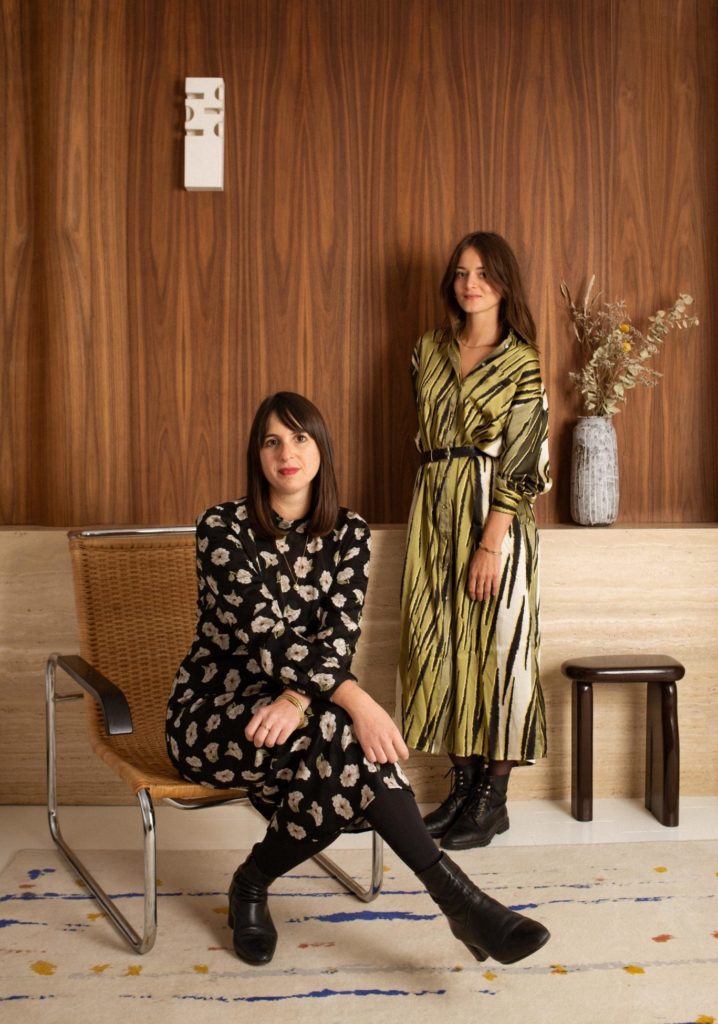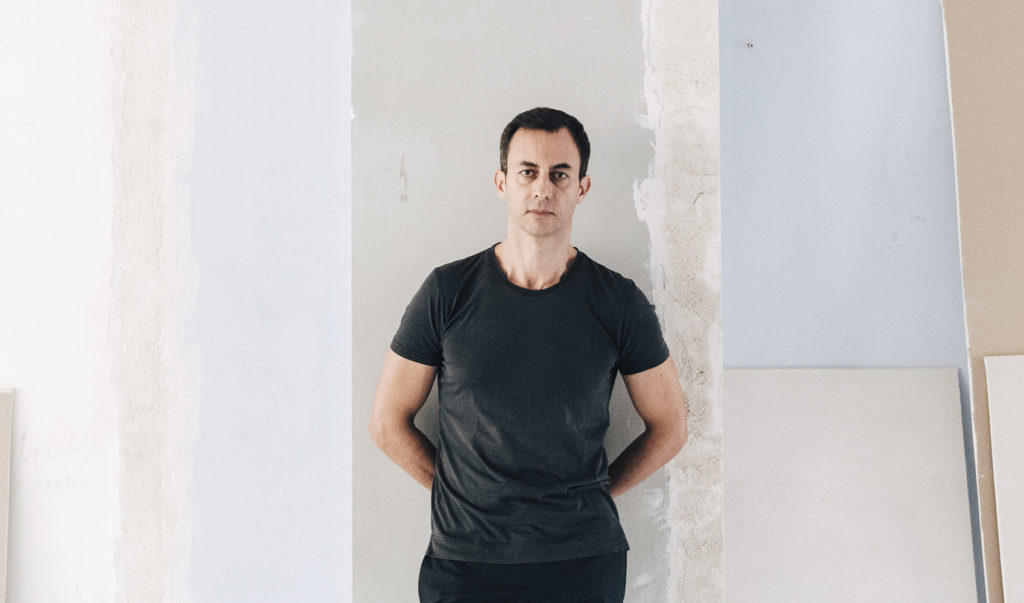Emma: “I had been following the work of Cobalto Studio for some time, I had fallen in love with their aesthetics, which I felt so close to. They knew Sessùn and our work, especially through Sessùn Alma. We share the same values, the same love of the South and Mediterranean know-how, far from clichés. When the project in Madrid took shape, I contacted them. Our meeting and collaboration was so fluid, we spoke the same language.”
The Sessùn concept store in Madrid by
Cobalto Studio
Hotels & restaurants
1 March 2021
It was in the heart of the Iberian capital, precisely in the Justicia district, that Emma François from Marseille and Gabriel Escámez from Barcelona met to imagine the first Spanish concept store of Sessùn. A meaningful collaboration between the founder of the brand and the architect at the head of Cobalto Studio. Between them, a double evidence: the love of the Mediterranean and craftsmanship in all its aspects.
A perfect duo to imagine this plural place where the Sessùn collections and a selection of books, ceramics, handcrafted pieces and works of art cohabit. Visit this new kind of artist’s workshop.
Sessùn Madrid, Calle de Fernando VI, 13, 28004 Madrid, Spain
How did you met?
Gabriel: “Sessùn contacted us to lead their opening in Spain and we couldn’t be more excited. The vision of the brand is very aligned to the cultural heritage that also represents Cobalto Studio. Therefore this collaboration gave us a very special opportunity to delve deeper into our roots and the artistic expressions that we love.”
Why Madrid and in particular the Justicia district?
Emma: “We had been in Spain since the creation of the brand in multi-brand shops and we felt it was important to open a shop in Spain that would reflect our image.
It was while strolling around Madrid, discovering the city, that we discovered by chance the Justicia district that we fell in love with. This district, where real local life beats, is spared the presence of international brands, and that’s what makes it so charming. There are many antique shops, bookshops and pretty independent shops.”
The intention of this first Iberian shop?
Emma: “The shop has been designed as a multi-purpose space, to accommodate not only the Sessùn and Sessùn Oui textile collections but also a selection of artists, craftsmen and designers. The memory and identity of the space have been preserved, to keep its soul and respect its history.”
What was the common thread running through this project?
Gabriel: “The overall concept alludes to an artist’s workshop, whose pieces offer a reminiscence of Cubism and traditional African Art. Besides the cubist scheme that runs throughout the design, some stone blocks that have been almost excised from the quarry in a very brutalist way, can be also found both on the counter and in other parts of the store. We also included art pieces that brought us back to a more essential expression of nature (using natural fibers such as linen, robe, esparto,…) that have also been a big inspiration.”
Two words to define the concept store?
“Solar & Matteric”
THE COLOR PALETTE
Gabriel: “The color palette has been predominantly white (with both gloss and matte finishes) and dark wood tones. For fabrics and paintings, we took inspiration from shades of a Mediterranean sunset, and tones such as mustard, natural tones and brown are very present. The use of crafts is evident in ceramics and basketry.”
How was the place conceived?
Gabriel: “We have preserved characteristic elements of the local architecture: wrought iron pillars, beams, wooden floors, as well as granite panelling to respect and bring to life the memory of the place.”
“We finished the design with strong volumes that solve the project needs and give continuity to the entire perimeter through a rationalized basement, staggered at different heights, on which functional elements are placed.”
What materials did you use and why?
“The materials chosen are natural and local, handcrafted such as stone, wood or woven reed. We have chosen to use marble in particular. Its striated finish refers to the shafts of the columns in traditional orders. It appears as a central material of the shop, it is found in different pieces of furniture, in very simple forms, supported one to the other or in apparent balance… the whole thing is romantic like a field of ruins.”
The particular techniques revisited for this project?
Gabriel: “The essence of Cobalto Studio is to study and understand the pre-existence of a space and its heritage to adapt it to a more contemporary point of view. And, in this sense, the new Sessùn store in Madrid is no exception. The studio achieves an enveloping atmosphere thanks to the presence of natural materials and the encounter between untreated and other polished surfaces. A technique that we used is a traditional carving and modeling of the stone elements of the store.”
How the space is organized?
Emma: “In a large first part, the influences intermingle to adorn the space with a warm and authentic aura. It is a perfect showcase for the textile collection, books and carefully selected objects.
Then you arrive in a spacious fitting room, designed as a space in its own right. And finally the last space, open onto the courtyard, hosts Sessùn Oui, the wedding collection.”
The artistic movements that inspired you for this project?
Emma: “Brancusi, the homes of Catalan artists in the mid-twentieth century, brutalism.”
Gabriel: “Mainly cubism, traditional African art, brutalism.”
Your architectural & design influences?
Emma: “But also Jean Touret’s furniture, Vince Skelly’s pieces, as well as the house of the designer Marzia Chierichetti in Kenya.”
How does this place reflect the Sessùn philosophy?
Emma: “It reflects everything we love and the pillars of the brand: the love of know-how and homage to craftsmanship on the one hand, and curiosity and openness to others as a source of unlimited creation on the other hand.”
How does your new ceramic line fit into this space?
Emma: “In harmony, the burnt earth tones respond to the dark waxed wood and marble of the entrance.”
A singular collaboration for this place?
Gabriel: “At the moment Adriana Meunié, an artist that we have worked with for this project and that helped us create a direct link to nature. Her creative universe revolves around raw and natural materials, the touch and durability of pieces that are embellished with the passage of time. As she works mainly with natural fabric we fell in love with her work.”
What are your upcoming projects?
Emma: “Always more consolidate our relations with the craftsmen. Open a place like Sessùn Alma or Sessùn Madrid in Paris.”
Emma and Gabriel's selection

Find this object
Amini
Tapis Il Volo

Find this object
Raphael Navot
Sofa

Find this object
Pamono
African Wooden Stool

Find this object
101 Copenhagen
Brutus Chair

Find this object
Peter Chadwick
Archi Brut

Find this object
Mano Mani
Ceramics

Find this object
D'Aquino Andrea
A Life Made By Hand - The Story Of Ruth Asawa

Find this object
Numero 74
Gold padded cover S024

Find this object
Sessun
Sac Mini Tano Suede

Find this object
Sessun
Melissande Sandals

Find this object
Sessùn
Patchwork Cushion

Find this object
Sessùn
Sac Tessao patch

Find this object
Marta Bonilla - Sessùn
Volta Lamp

Find this object
Estefania - Sessùn
Sahara plate

Find this object
Cécile Ducommun - Sessùn
Vase Theogonie

Find this object
Sessùn
Mural Miciola GM

Find this object
Sessùn
Jean Rosaka

Find this object
Sessùn
Rimiez PM wastebasket

Find this object
Sessùn
Combi-short Emmanuelle

Find this object
Aline Chemla - Sessùn
Wall hanging Vase

Find this object
Estefania - Sessùn
Raw vase

Find this object
A week abroad - Sessùn




























